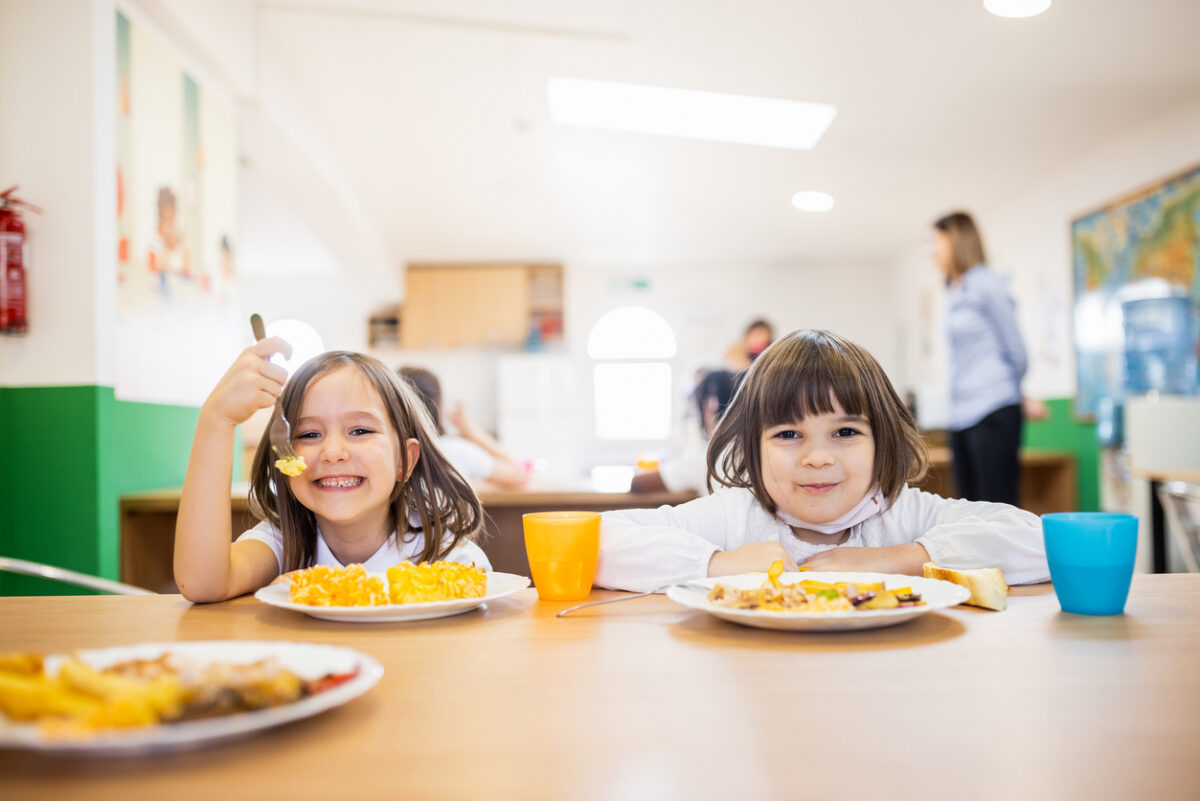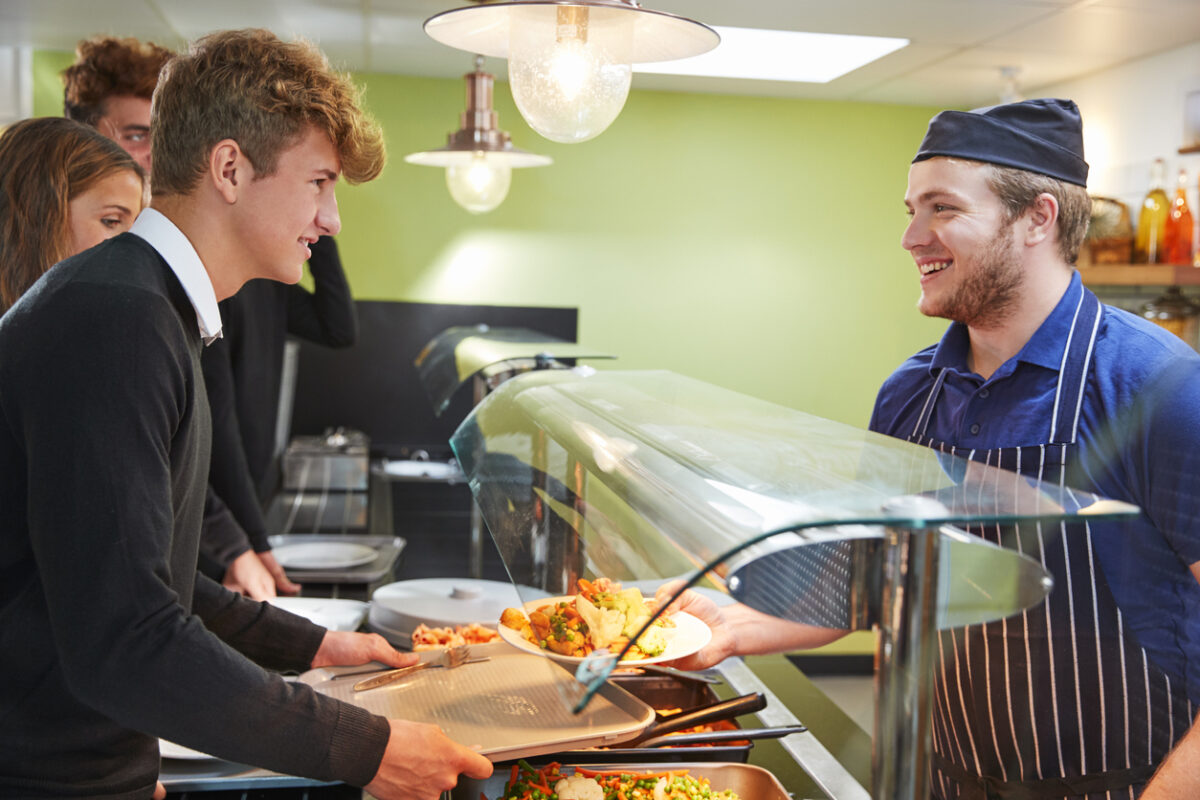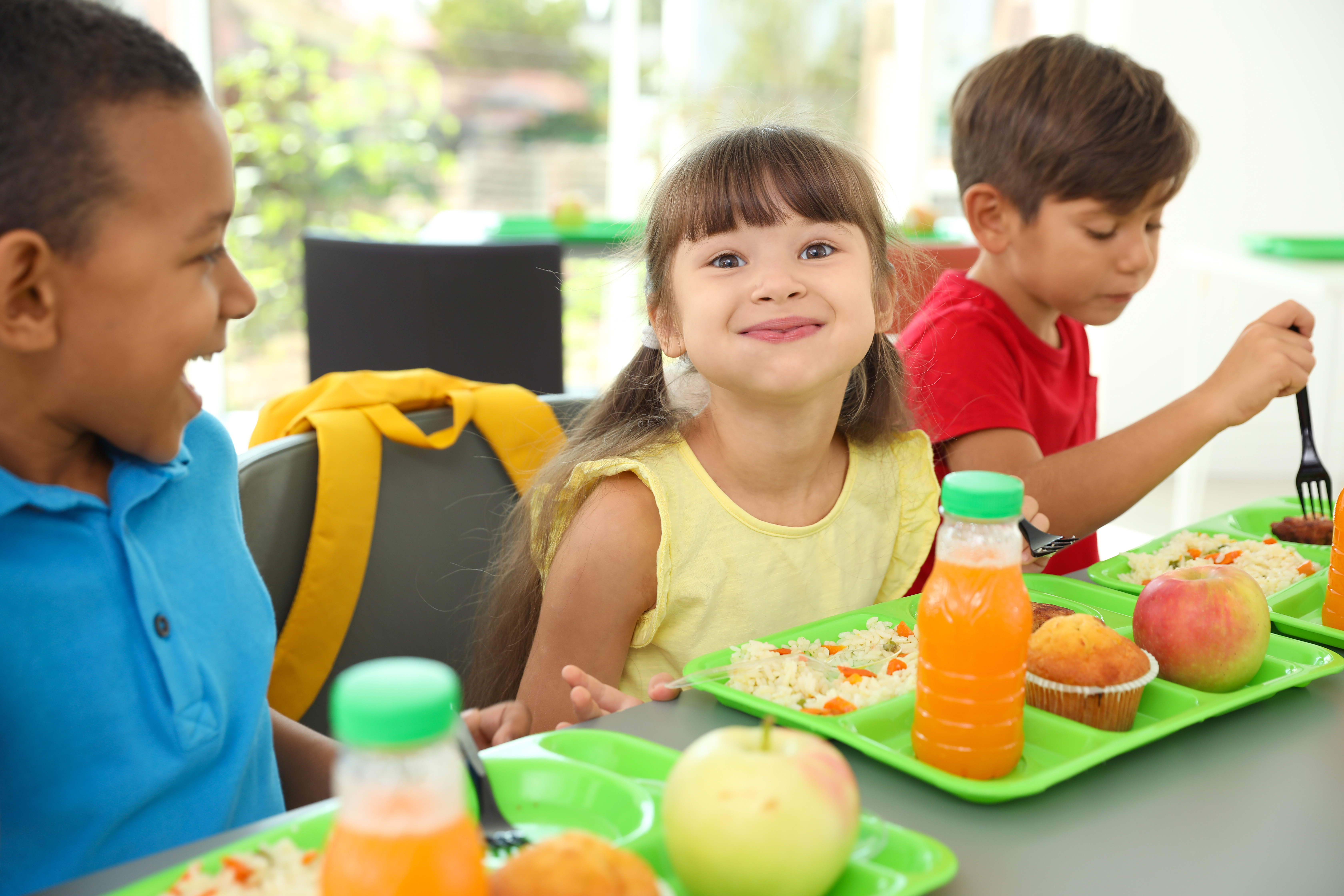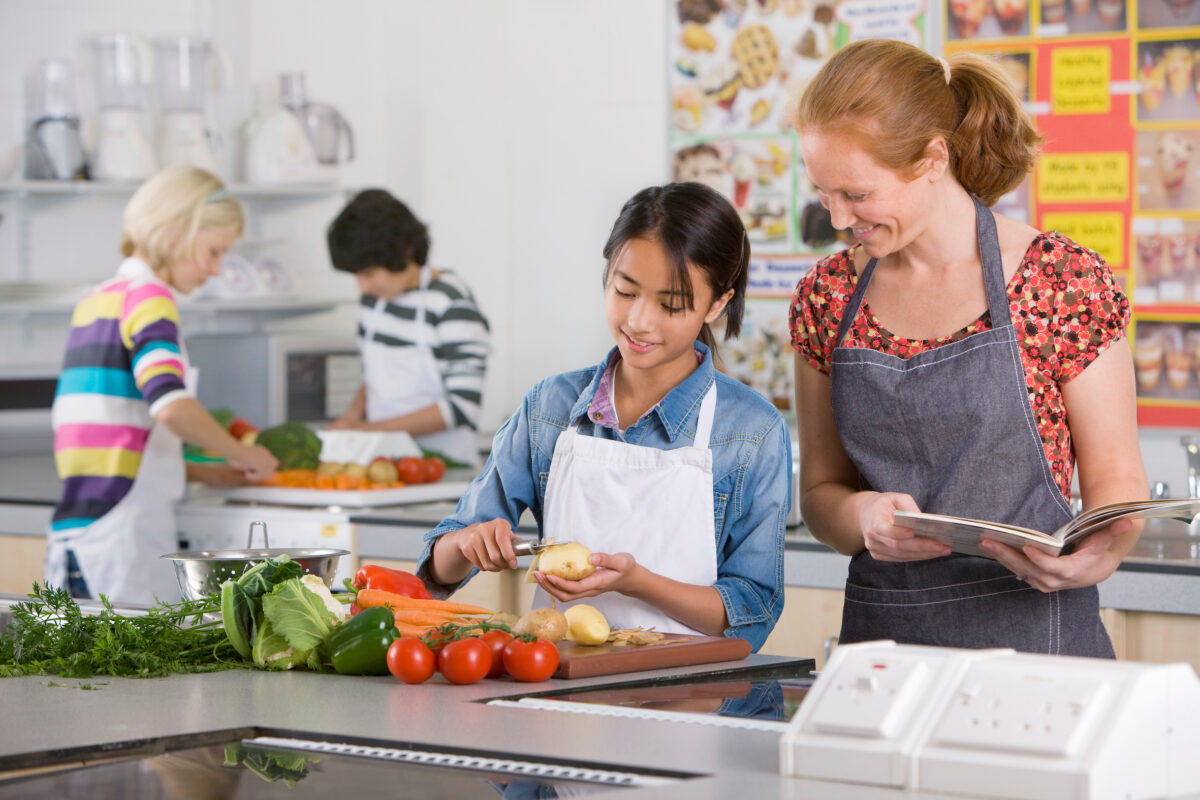Feeding future generations: school meals from around the world
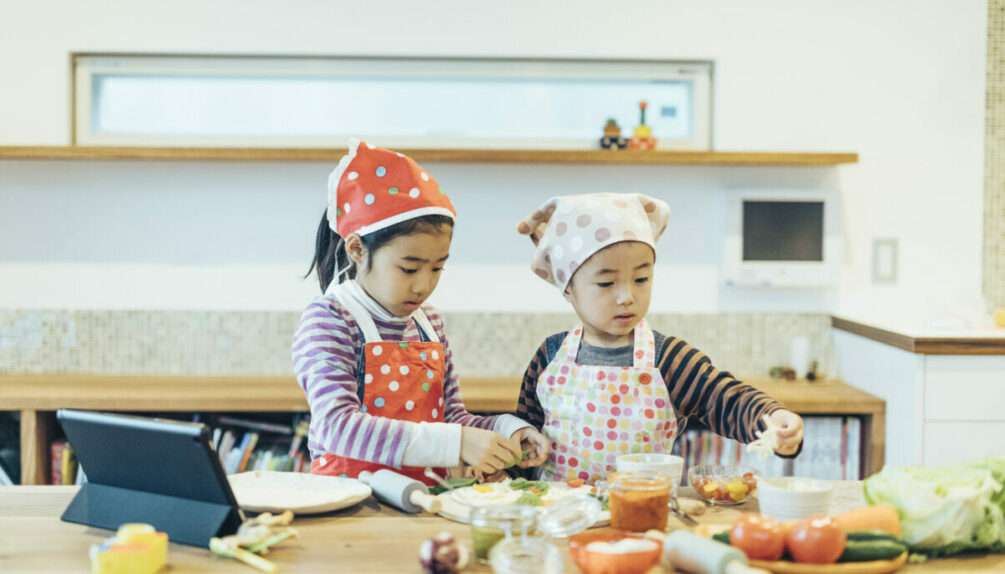
Some 418 million children globally are estimated to be receiving school meals regularly. For many pupils, the food they eat at school will make up most of their daily nutrient intake. School lunch provision not only ensures that kids are well fed, but has also been proven to boost academic performance, and it helps them understand the building blocks of a healthy lifestyle. While some countries provide free, nutritious school lunches, others have had to rely on non-profit organisations to step in. A wide range of approaches to school food are shaping pupils’ diets around the world, whether this be by encouraging kids to embrace healthier habits, sustainable diets, or to help them to reconnect with their heritage.
United States
The National School Lunch Program, first introduced in 1946 had a goal to ‘safeguard the health and well-being of the Nation’s children and to encourage the domestic consumption of nutritious agricultural commodities and other foods.’ Over the years however, US school meals have built a reputation for being closer to junk food than nutritious produce. For example, the options available on an elementary school lunch menu from 2010 include many ultra-processed foods like soy baked chicken nuggets, cheese pizza, nachos, corn dogs, hamburgers, macaroni cheese and sugary flavoured milks.
Efforts are now being made to give children healthier options, with the USDA Food and Nutrition Service proposing new nutritional standards for school meals in February 2023. It has called for schools to lower the levels of added sugar in school lunch and breakfast foods like cereals, yoghurts, grain-based desserts, and flavoured milks, so that an average of less than 10% of calories per meal contain added sugars. Schools are also being asked to gradually reduce the levels of sodium in lunches by 10% each academic year between 2025 and 2030.
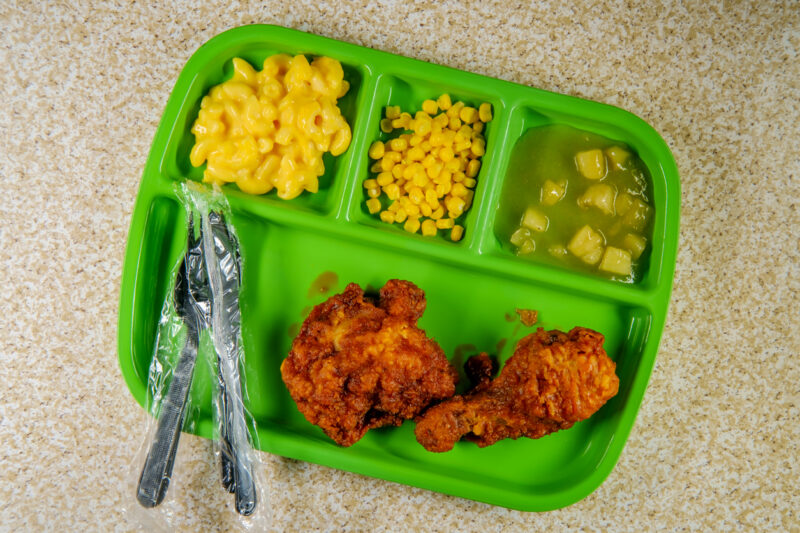
A typical lunch tray in the US, featuring deep fried chicken legs with macaroni and cheese, sweetcorn, and apple sauce
A typical lunch tray in the US, featuring deep fried chicken legs with macaroni and cheese, sweetcorn, and apple sauce
Finland
Finland was the first country in the world to start offering free school lunches to all in 1943. Today, every child still receives free meals from the day they start in infant school until they finish their studies. According to national guidelines, a typical lunch should include a hot dish (usually a protein like fish, lean meat or a vegetarian option), a carbohydrate (like potato, barley, mixed grains, whole grain pasta or rice), a vegetable side dish (salad, or raw/warm vegetables), and an oil-based salad dressing. Drinks are either low fat milk or water, while additional sides can include wholegrain bread with margarine and a portion of fruit. While schools in the country are eligible to receive the EU’s school milk, fruit and vegetable subsidies, the Finnish government also pays an additional subsidy to supply its schools with organic foods.
Pupils are required to serve themselves and tidy up once they’ve finished, composting any leftovers. They are also asked to take part in regular surveys so they can decide what features on future menus. In 2021, five lower secondary schools in the municipality of Espoo took part in a school meal project which aims to reduce waste in the canteen. As part of the project, children took part in recipe competitions to develop tasty vegetarian meals, with the top recipes being integrated into school menus in comprehensive schools (7 to 16 years) and upper secondary schools (16 to 18/19 years.)
Sweden
In Sweden, free meals are offered to all children ages 7-16 years, and to most kids aged 16-19. Teachers are encouraged to eat lunch with the kids to stimulate conversations around food and health – a widely embraced (though not mandatory) concept called ‘pedagogic lunch.’ Since 2011, Swedish schools have had to ensure meals include over 30% of a child’s recommended daily nutrient and energy intake. According to the Swedish Food Agency, lunch comprises a warm meal, a salad buffet, a piece of bread, and milk or water to drink. Most schools don’t serve any sweetened drinks, baked goods or desserts with their meals. While it isn’t obligatory to offer a vegetarian alternative, 60% of Swedish municipalities now do.
In 2012, a free web-based platform called SkolmatSverige (School food Sweden) was launched to help schools monitor the quality of food offerings. The online tool can give schools feedback around food choice and provision, nutritional adequacy, food safety and hygiene, service and the pedagogic lunch system, environmental impact, and organisation and policy. The tool assesses the nutritional value of meals by analysing their vitamin D, fibre, iron, and fat content – micronutrients which were lacking in children’s diets prior to 2011. In 2016, around one in three primary schools were signed up to the digital system in 255 out of 290 municipalities.
Sri Lanka
Malnutrition has affected Sri Lanka for many years, but became more chronic in 2022 when the country faced its worst economic crisis since it became independent in 1948, with its economy shrinking by 7.8% and inflation rising to 50% per year. Prior to the recession, some one million children relied on free school meals as their main source of food, according to Save the Children, with families struggling to provide it for them at home. Since government funding was cut to its school meal programme, many schools stopped serving food, with the few that still could, serving unbalanced and carbohydrate-heavy dishes.
As the situation deteriorated, independent programmes were established like Rise up School Meals. “We initially intervened as an emergency intervention,” says Vijitha Nanayakkara, founder and CEO of Rise Up. Launching in June 2022, the organisation started offering mid-day meals to over 2,000 students in five schools across the country. In the following months, the project reached nearly 3,800 students in an additional 24 schools. A year on, Rise Up has provided meals to more than 12,000 kids in 81 schools. “If kids are not nourished, then you cannot expect them to perform to their potential in education and day to day life,” Vijitha says. “School meals should not be considered as an interim solution or welfare measure when we are in a crisis, [they have] to be part and parcel of the ecosystem.”
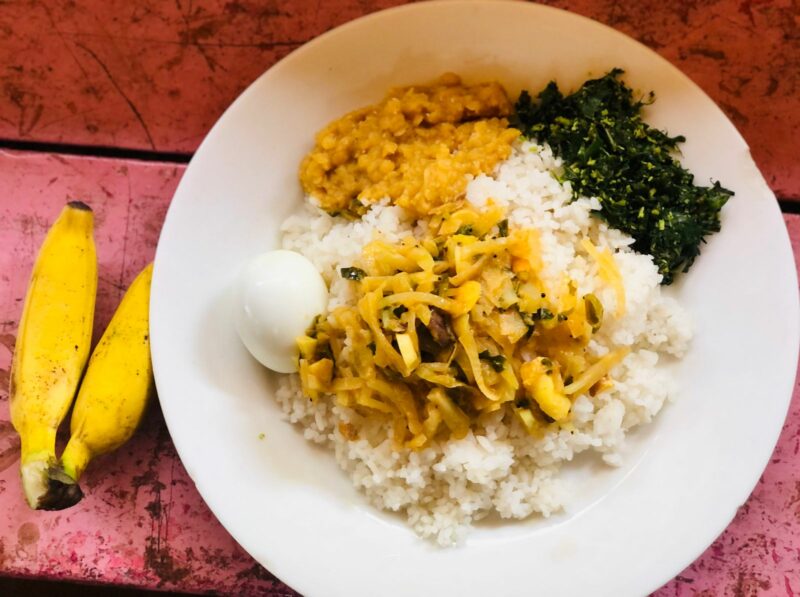
An example of Rise Up’s vegetarian meal offering. Credit: Rise Up School Meals
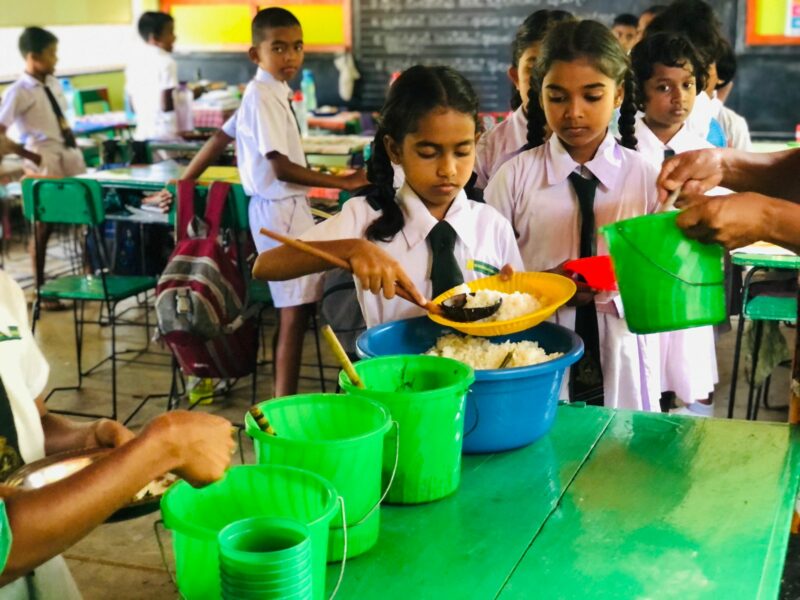
Young student serves herself rice in her classroom in Sri Lanka. Credit: Rise Up School Meals
Left: An example of Rise Up’s vegetarian meal offering. Credit: Rise Up School Meals
Right: Young student serves herself rice in her classroom in Sri Lanka. Credit: Rise Up School Meals
Meals are developed every day by the group’s in-house nutritionists, and usually include the core components of rice, vegetables, protein and fruit. Protein sources vary depending on where the school is located, says Vijitha, with chicken being popular, and fresh or dried fish being offered at schools located near the coastline. Mushrooms, eggs, and pulses are also offered in schools where students follow religions that require them to refrain from consuming meat during holidays such as the Buddhist festival Vesak Poya.
What makes Rise Up unique is its focus on sourcing and preparing food with the help of the children’s parents. “It’s a community mobilisation,” says Vijitha. “The parents were more concerned than anybody else because it’s their kids who are at risk. So, we formed the Rise Up parent community in schools, and parents cooked themselves and spent some two to three hours in school on a roster basis. It educates them on the importance of a proper meal, and [gives them] an opportunity to contribute by way of helping in the meal preparation process.” Some parents also grow their own fruit and vegetables at home for the meals, while the remaining produce is sourced from local farmers and school gardens which the organisation has built in several schools since September 2022. Sourcing local ingredients is essential to help kids understand how easy it is to make use of food grown close by. “[During the financial crisis], most of the key things which we could have grown internally we chose to import,” adds Vijitha, “[consequently] we had an unnecessary import bill and fuel shortage. The produce could not be transported from one place to another – a classic example of why you need to have the food as close as possible to the consumption location.”
Brazil
Out of all the countries on this list, Brazil’s National School Feeding Program (Programa Nacional de Alimentaćão Escolar) serves the most children, with estimates suggesting around 40 million kids receive meals from the scheme. The programme serves children at all public and community schools in the basic education level – from day care and kindergarten (ages 18 months to three) through to secondary school.
The national school meal guidelines require all lunches to provide at least 20% to 70% of a pupil’s daily nutrient intake. A typical meal features rice and beans, some variety of protein (usually chicken, beef, pork, egg, or fish), vegetables and fruit. Locally sourced produce is also essential. Since 2009, city school feeding programmes have been required by law to set aside at least 30% of their school meal budget towards supplying food from small-scale food producers. Nutritionists oversee the development of menus to ensure meals provide the required daily energy amounts and nutrients, and are also tailored to specific regional eating habits and make use of local crops.

A midday school meal in Brazil, with chicken breast, white rice, beans, and toasted manioc flour
A midday school meal in Brazil, with chicken breast, white rice, beans, and toasted manioc flour
In more recent years, the country has also tried to increase the number of plant-based food offerings in schools. In 2018, four cities in the north-eastern state of Bahia (Serrinha, Barroca, Teofilandia and Biritinga) announced they would make all public school meals 100% plant-based by the end of 2019, reducing amounts of meat, dairy and egg in meals by 25% per semester. The project, called the Sustainable School Program, was developed in partnership with Brazil’s Humane Society International and the regional Public Prosecutor Office. Some examples of the meals offered on the sustainable weekly menus include a lettuce salad with rice, beans, okra and a pumpkin soya chunk casserole, a plant-based shepherd’s pie, vegetable couscous, and cornmeal porridge with papaya. In 2022, the municipality of Salvador also introduced a scheme to serve over 10 million plant-based meals to more than 170,000 students. The initiative was launched via an agreement between Conscious Eating Brazil, Humane Society International and Salvador City Hall.
Japan
Japan’s national school food programme is often hailed as one of the best in the world. School lunches are served in all nursery and primary schools and nearly 90% of junior high schools (ages 12 to 15). The lunch menu is prepared by a qualified nutritionist, who runs a nutritional education programme in schools called shokuiku (meaning ‘food education’), where they advise staff around food hygiene and preparation, and offer workshops to primary schools to help students make healthier eating choices. As part of shokuiku lessons, pupils may undertake a number of activities such as visiting local farms and learning first-hand about planting and harvesting rice and vegetable and caring for livestock. The nutritionists also work with children’s families to educate them around healthy eating and food hygiene at home. At lunchtime, kids generally eat in the classroom with their fellow classmates and teachers, where they are also taught about manners, eating well, how to prepare their eating space and clean up after themselves.

An example of a Japanese school lunch, with grilled salmon and sesame seeds, a fried egg on white rice, vegetables, and a small portion of apples and blackberries
An example of a Japanese school lunch, with grilled salmon and sesame seeds, a fried egg on white rice, vegetables, and a small portion of apples and blackberries
According to Japan’s Ministry of Education, school lunches should provide kids with a third of their daily energy intake, as well as include foods that deliver 50% calcium, 33% magnesium, 40% iron, vitamins A and B2, and 33% vitamin C. School lunches often feature a main dish, made from proteins like meat, fish, egg or soybean and side of vegetables such as mushrooms, potatoes or seaweed, a soup dish such as miso, a carbohydrate like rice, bread or noodles, and milk to drink. Desserts seem to be fairly uncommon, but if offered will typically be a portion of fruit or a small sweet treat like cake or pudding during holiday periods like Christmas.
France
According to the national nutritional guidelines provided by the GEM-RCN for the public catering system in France, a lunchtime meal should include four or five parts, featuring: a starter, a protein-based dish, side dish, dairy product, and/or dessert. Not all schools will choose to offer all five courses, but guidelines note a main course, side dish and dairy product are essential. Some 15 different types of dishes should be served across four weeks. These dishes must also meet specific ‘frequency criteria’, meaning foods that are high in sugar, salt and fat are limited, allowing kids to still enjoy them, just less often. A starter which has more than 15% fat can only be served four times across the month for example, while desserts or dairy products containing over 20g of total simple sugars per portion and less than 15% fat can be served four times across the period. Over half of pupils in the country eat from the school canteen, says the French Ministry of Education.
In 2021, under its Climate and Resilience law, the French government introduced a new rule that 50% of school meals should be made up of high quality, sustainable foods, with at least 20% being sourced from organic farms. The law also made it obligatory for canteens to make vegetarian meals available at least once a week on school menus from January 2023. While it is mandatory for all schools to comply with this law, an investigation led by Greenpeace in 2020 showed nearly 30% of primary schoolchildren didn’t have vegetarian options at their school, proving there’s still work to be done to increase the availability of meatless options.
Italy
Like France, Italy’s government also has national guidelines for school catering which encourage certain foods and food groups to be served a specific number of times a week. Meals are comprised of first and second courses, a side dish, a piece of bread and fruit. The guidelines state that a daily school lunch plate should feature one portion of fruit and vegetables, one portion of cereals like pasta, rice, barley, or polenta, one portion of bread, legumes once or twice a week, meat and fish one to two times a week, an egg once a week, cheese once a week, and cold cuts twice a month. Potatoes should be served once during the week or not at all, while single dishes like pizza or lasagne are allowed once a week.
Since 2010, Italy’s Ministry of Health introduced new guidelines to encourage school canteens to serve a ‘zero-mile diet’, offering kids more locally sourced, organic foods. In 2013, the Ministry of Health together with the national government research agency Istituto Superiore di Sanità (‘Superior Institute of Health’), launched MaestraNatura (‘NatureTeaches’), an online nutrition education programme targeted at schoolchildren aged 6-14. It teaches them about the relationship between food and personal health and wellbeing, and the local environment, and aims to improve the overall food literacy of the next generation.
Germany
The development of school meals in Germany is the responsibility of its 16 federal states. For menus to be implemented into schools, school caterers must submit menu proposals in their call for tenders to local authorities who then provide funding for the kitchen equipment and staff needed to prepare and serve the meals.
Another issue which makes Germany’s school food system complex is the fact that not all primary schoolchildren spend their whole day at school, with many leaving school at lunchtime and eating at home. The programme ‘Investment, Future, Education and Care’ (IZBB) was introduced between 2004 and 2007 to promote the expansion of all-day schools in the country, which are the only schools to offer hot meals at lunchtime. Approximately 3.4 million students out of the total 8.7 million were reported to be attending all-day schools in 2021 according to federal office statistics. Berlin is the only federal state to offer free school meals to all children, while parents in other states must pay for meals. Low-income families with basic income support can have this sum reimbursed if they receive education benefits.
The German Nutrition Society (DGE) provides guidelines to advise caterers in their menu planning. The organisation first introduced its Quality Standards for School Meals in 2007 as part of the country’s national initiative ‘IN FORM’ which aimed to promote healthy diets and physical activity. Since then, its guidelines have been regularly updated, and today ensuring schoolkids follow healthy diets has remained a priority, with ethical and climate-friendly foods also being recommended.
Depending on the school, German students are entitled to receive breakfast, lunch, and snacks. Breakfast guidelines encourage the provision of wholemeal bread rolls, no added sugar muesli, fresh or frozen fruits, plain yoghurt, cheese, and cold cuts. Lunch can feature wholemeal products, potatoes, parboiled or brown rice, vegetables, legumes, or salad, unsweetened fresh or frozen fruit, unsalted nuts, milk, plain yoghurt, buttermilk, sour milk, kefir, and lean meats such as chicken, turkey; sausages, or fish. Plain water or herbal tea without added sugar or sweeteners are the recommended beverages. According to the DGE, across a four-week period, meals should include a maximum of eight meat or sausage dishes, with a minimum of four including lean muscle meat and another four featuring saltwater fish. It also recommends a minimum of eight portions of fruit, and a minimum of eight servings of milk or milk -based products. Vegetables should be present in every meal, as should grain products or potatoes, with wholemeal products being the preference.
While part of the DGE’s recommendations for school food includes offering a daily vegetarian meal, plant-based meals aren’t yet an option, which initiatives like ProVeg’s Plant-Powered Pupils are trying to change. Since launching the campaign in 2016, Plant-Powered Pupils has hosted over 110 events across the country, such as training sessions for catering companies to help them prepare nutritious, sustainable plant-based meals, as well as in-class workshops with children, teaching them about the benefits of eating more plants and how to make more eco-conscious food choices. “Because of lacking recommendations and pressure from parents (for a lack of knowledge) demanding meat frequently, many decision makers are still reluctant to go more plant-based”, says the Proveg Plant-Based Pupils team. “On the bright side: Those recommendations are currently being revised, and we are very much looking forward to learning about the new ones which are supposed to be more advanced in this regard.”
Canada
As Canada has no national school food policy in place, school meal provision is either organised by children’s parents, or by the numerous school food programmes led by non-profit organisations, such as the Coalition for Healthy School Food – a group of over 260 charities working across the country’s 10 provinces and three territories – and the Breakfast Club of Canada. These organisations help to provide breakfast, lunch, and snacks to kids across the country. While the promise of developing a national policy for school meals was included in the nation’s 2022 federal budget, no deadline has been set for its implementation.
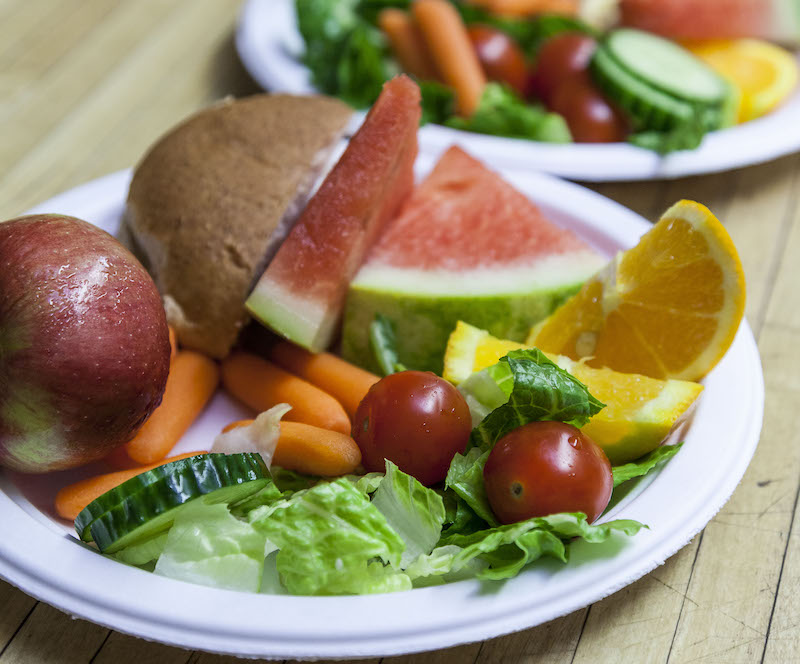
A lunch plate from the school salad bar programme at James S. Bell Middle School, Toronto, Canada, supported by the Coalition for Healthy School Food, featuring watermelon and orange slices, carrots, tomatoes, cucumber, salad leaves, an apple, and a small wholemeal roll. Credit: Laura Berman, Greenfuse Photography
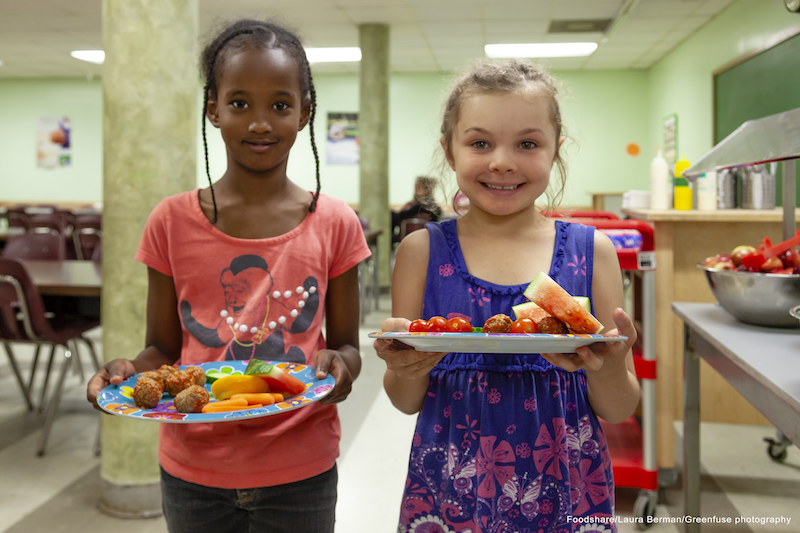
Two young girls holiding plates of food from the salad bar. Credit: Laura Berman, Greenfuse Photography
Left: A lunch plate from the school salad bar programme at James S. Bell Middle School, Toronto, Canada, supported by the Coalition for Healthy School Food, featuring watermelon and orange slices, carrots, tomatoes, cucumber, salad leaves, an apple, and a small wholemeal roll. Credit: Laura Berman, Greenfuse Photography
Right: Two young girls holiding plates of food from the salad bar. Credit: Laura Berman, Greenfuse Photography
Without a national school food policy, it’s hard to know exactly what Canadian kids eat every day in the canteen. The Coalition supports the advice provided in Canada’s 2019 Food Guide snapshot, which promotes having half a plate full of fruits and vegetables, while a quarter of the plate should include proteins like lean meats, eggs, nuts, fish, tofu and pulses, and the other quarter should be filled with wholegrain foods. It also recommends that school food programmes should, where possible, involve kids in the selection and preparation of meals, prioritise locally sourced foods and recognise that the range of cultural diversity across Canada should influence what meals are available.
Independent programmes are also run for indigenous peoples and their children. Some of these initiatives work to address the problem of diabetes, which continues to disproportionately affect these communities. One such scheme is the Yukon First Education Directorate’s (YFNED) Nutrition Program, which aims to bring healthier options to young people by helping them reconnect with food traditions from their culture in schools. A team of 20 cooks work out of nine school-based kitchens in the province. YFNED’s goal is not only to help schools incorporate Indigenous food practices such as seasonal harvesting and preservation into meal preparation, but also allow indigenous kids to rediscover foods that are traditional to their culture, such as bison, salmon, and caribou.




